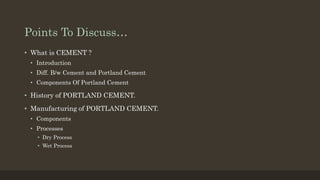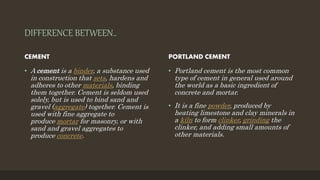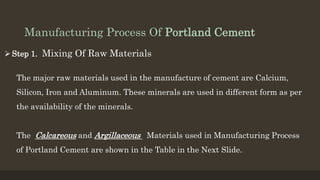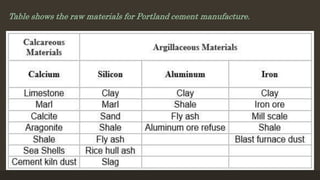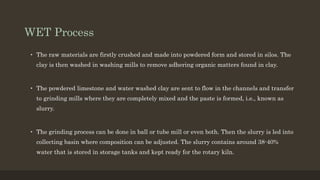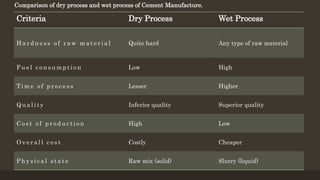Manufacturing of cement
- 1. Manufacturing Of Cement PORTLAND CEMENT
- 2. Points To Discuss… • What is CEMENT ? • Introduction • Diff. B/w Cement and Portland Cement • Components Of Portland Cement • History of PORTLAND CEMENT. • Manufacturing of PORTLAND CEMENT. • Components • Processes • Dry Process • Wet Process
- 3. INTRODUCTION TO CEMENT • Cement is a fine mineral powder manufactured with very precise processes. Mixed with water, this powder transforms into a paste that binds and hardens when submerged in water. Because the composition and fineness of the powder may vary, cement has different properties depending upon its makeup. • Cement is mainly used as a binder in concrete, which is a basic material for all types of construction, including housing, roads, schools, hospitals, dams and ports, as well as for decorative applications (for patios, floors, staircases, driveways, pool decks) and items like tables, sculptures or bookcases
- 4. DIFFERENCE BETWEEN.. CEMENT • A cement is a binder, a substance used in construction that sets, hardens and adheres to other materials, binding them together. Cement is seldom used solely, but is used to bind sand and gravel (aggregate) together. Cement is used with fine aggregate to produce mortar for masonry, or with sand and gravel aggregates to produce concrete. PORTLAND CEMENT • Portland cement is the most common type of cement in general used around the world as a basic ingredient of concrete and mortar. • It is a fine powder, produced by heating limestone and clay minerals in a kiln to form clinker, grinding the clinker, and adding small amounts of other materials.
- 5. Components of PORTLAND CEMENT • Basic Chemical Components • Calcium (Ca) • Silicon (Si) • Aluminum (Al) • Iron (Fe) • Typical Raw Materials • Limestone (CaCO3) • Sand (SiO2) • Shale, Clay (SiO2, Al2O3, Fe2O3) • Iron Ore/Mill Scale (Fe2O3)
- 6. HISTORY of Portland Cement Portland cement was developed from natural cements made in Britain beginning in the middle of the 18th century. Joseph Aspdin took out a patent in 1824 for "Portland Cement," a material he produced by firing finely-ground clay and limestone until the limestone was calcined. He called it PORTLAND CEMENT because the concrete made from it looked like Portland stone, a widely-used building stone in England. Joseph Aspdin
- 7. MANUFACTURING Of PORTLAND CEMENT Portland cement is made by heating raw materials rich in oxides of silicon, calcium, aluminum and iron to temperatures of around 1200 - 1400o C. The chemical reactions that occur within the partially molten mass result from the formation of the four main cement materials. Tricalcium silicate (CaO)3•SiO2 C3S 45-75% Dicalcium silicate (CaO)2•SiO2 C2S 7-32% Tricalcium aluminate (CaO)3•Al2O3 C3A 0-13% Tetracalcium alumino-ferrite (CaO)4•Al2O3•Fe2O3 C4AF 0-18% Gypsum CaSO4•2H2O CS̅H2 2-10%
- 8. Manufacturing Process Of Portland Cement Step 1. Mixing Of Raw Materials The major raw materials used in the manufacture of cement are Calcium, Silicon, Iron and Aluminum. These minerals are used in different form as per the availability of the minerals. The Calcareous and Argillaceous Materials used in Manufacturing Process of Portland Cement are shown in the Table in the Next Slide.
- 9. Table shows the raw materials for Portland cement manufacture.
- 10. Manufacturing Processes Of Portland Cement There are 2-Types of Processes that can be used to Manufacture Portland Cement. Which are : Wet Process Dry Process
- 11. DRY Process • The both calcareous and argillaceous raw materials are firstly crushed in the gyratory crushers to get 2-5cm size pieces separately. The crushed materials are again grinded to get fine particles into ball or tube mill. • Each finely grinded material is stored in hopper after screening. Now these powdered minerals are mixed in required proportion to get dry raw mix which is then stored in silos and kept ready to be sent into rotary kiln. Now the raw materials are mixed in specific proportions so that the average composition of the final product is maintained properly.
- 12. Manufacturing of cement By DRY process
- 13. WET Process • The raw materials are firstly crushed and made into powdered form and stored in silos. The clay is then washed in washing mills to remove adhering organic matters found in clay. • The powdered limestone and water washed clay are sent to flow in the channels and transfer to grinding mills where they are completely mixed and the paste is formed, i.e., known as slurry. • The grinding process can be done in ball or tube mill or even both. Then the slurry is led into collecting basin where composition can be adjusted. The slurry contains around 38-40% water that is stored in storage tanks and kept ready for the rotary kiln.
- 14. Manufacturing of cement By WET process
- 15. Criteria Dry Process Wet Process H a r d n e s s o f r a w m a t e r i a l Quite hard Any type of raw material F u e l c o n s u m p t i o n Low High Ti m e o f p r o c e s s Lesser Higher Q u a l i t y Inferior quality Superior quality C o s t o f p r o d u c t i o n High Low O v e r a l l c o s t Costly Cheaper P h y s i c a l s t a t e Raw mix (solid) Slurry (liquid) Comparison of dry process and wet process of Cement Manufacture.
- 16. Step 2. Grinding Of Clinkers • The cooled clinkers are received from the cooling pans and sent into mills. The clinkers are grinded finely into powder in ball mill or tube mill. Powdered gypsum is added around 2-3% as retarding agent during final grinding. The final obtained product is cement that does not settle quickly when comes in contact with water. • After the initial setting time of the cement, the cement becomes stiff and the gypsum retards the dissolution of tri-calcium aluminates by forming tricalcium sulfoaluminate which is insoluble and prevents too early further reactions of setting and hardening. 3CaO.Al2O3 + xCaSO4.7H2O = 3CaO.Al2O3.xCaSO4.7H2O
- 17. Step 3. Storage and Packaging • The grinded cement is stored in silos, from which it is marketed either in container load or 50kg bags.
- 18. Manufacturing Process Of CEMENT
- 19. THANK YOU Made By – Pushpraj Choudhary

